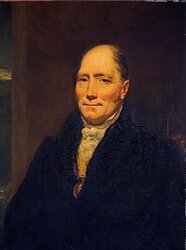Robert Stevenson
 Robert Stevenson, 1772-1850. Lighthouse Engineer. John Syme, Scottish National Portrait Gallery
Robert Stevenson was born in Glasgow, in 1772 and during the course of his lifetime contributed significantly to the development of lighthouse technology and Lighthouses on our coastlines.
Robert Stevenson, 1772-1850. Lighthouse Engineer. John Syme, Scottish National Portrait Gallery
Robert Stevenson was born in Glasgow, in 1772 and during the course of his lifetime contributed significantly to the development of lighthouse technology and Lighthouses on our coastlines.
His father, Alan, passed away while Robert was still an infant and his mother, Jane Lillie, arranged for him to attend charity schools, ultimately intending him to go into the ministry. When Robert was 15, his mother remarried - a man named Thomas Smith who was an accomplished mechanic and had recently been appointed as an engineer with the newly established Northern Lighthouse Board. Kinnaird Head was the NLB, and Smith's, inaugural Light - first lit in 1787.
Robert was mechanically minded also, and became Smith's assistant. The Lighthouse at Little Cumbrae on the River Clyde was the first that Robert was given sole supervision of, closely followed by two on the Pentland Skerries in Orkney. It was here Robert had a close brush with the dangers of the sea, as later recounted by his son, David Stevenson: "In returning from the Pentland Skerries in 1794, he embarked in the sloop 'Elizabeth' of Stromness, and proceeded as far as Kinnaird Head, where the vessel was becalmed about three miles from the shore. The Captain kindly landed my father, who continued his journey to Edinburgh by land. A very different fate, however, awaited his unfortunate shipmates. A violet gale came on, which drove the 'Elizabeth' back to Orkney, where she was totally wrecked, and all on board unhappily perished."
Robert married Thomas Smith's daughter in 1799, and the two had four children - David, Alan, Thomas and Jane. The three sons all became successful Lighthouse Engineers themselves. Robert had become Thomas Smith's business partner in 1797 and was also appointed as an engineer to the Northern Lighthouse Board - an appointment that was to last nearly 50 years, until 1842. During this time, Robert designed and supervised the construction of many lighthouses - developing and implementing many improvements to methods and engineering as he did so. The most famous of these is the Bell Rock Lighthouse - given the extreme location of the tower and the danger involved in the construction. Improvements developed by Robert included the implementation of giving lighthouses individual 'signatures' so that the lights could be individually identified by mariners.
Robert died on 12th July, 1850 in Edinburgh. Below is a list of the other lighthouses he designed:
-
Bell Rock Lighthouse (1811)
-
Isle of May (1816)
-
Corsewall (1818)
-
Point of Ayre (1818)
-
Calf of Man (1818)
-
Sumburgh Head (1821)
-
Rinns of Islay (1825)
-
Buchan Ness (1827)
-
Cape Wrath (1828)
-
Tarbat Ness (1830)
-
Mull of Galloway (1830)
-
Dunnet Head (1831)
-
Girdle Ness (1833)
-
Barra Head (1833)
-
Lismore (1833)

